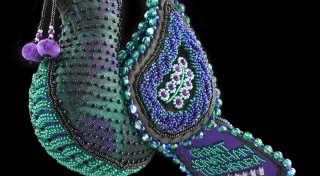
Tuscarora Raised Beadwork
As part of the "Each One Inspired" art exhibition at the Richard F. Brush Art Gallery of St Lawrence University, beadwork artist Grant Wade Jonathan gave a lecture about the origins, traditions, and practice of Tuscarora Raised Beadwork. As well as being a beadwork artist, Grant Wade Jonathan is an attorney in the EPA's American Indian Environmental Office in New York City. Artwork from the Iroquois Six Nations are included in the exhibition. The Iroquois Confederation consistes of the Mohawk, Oneida, Onondaga, Tuscarora, Cayuga, and Seneca tribes, all of which reside near and along Lake Ontario and the St Lawrence Seaway.
The Tuscarora tribe became part of the Iroquois Confederacy around 1722 CE as the sixth member tribe of the Haudenosaunee (Iroquois) after migrating north back to their original lands from North Carolina. Goat Island, near Niagara Falls on the US side of the border, became a traditional place for the Tuscarora bead workers to sell their work. Today the tribe has a permanent settlement near Lewiston, NY in Niagara County. There is no "Niagara Tribe” or reservation, an historical misconception.
Tuscarora Raised Beadwork consists of stitching techniques, called a Rope Stitch or Hump Stitch, that give an embossed or raised appearance to the beading. There is uncertainty about where and when the traditional art began and where the first materials came from. Many designs include the paper pattern underneath the beadwork sewn into the item to provide a brighter look to the clear glass beads. Common elements include a bird’s nest type of bead grouping with early work using plain clear glass beads. Over time bead workers gradually started using colored glass beads.
Pieces are adorned with various themes that include flowers, plants, animals, birds, squirrels, owls, and insects. Functional items such as card cases, purses, picture frames, pin cushions, needle cases, wall pockets, and wall hangings were all created and adorned with beadwork.
Through Tuscarora Oral history there is knowledge of how the tribe was granted the right to sell their beadwork near Niagara Falls. In the war of 1812 men of the Tuscarora tribe served under Major General Peter Buell Porter a US soldier, lawyer, and politician. Porter owned the lands adjacent to Niagara Falls on the US side of the border with Canada. For the war service of the Tuscarora fighters the Porter family granted the right to sell beadwork at Niagara Falls to the Tuscarora in perpetuity.
The Tuscarora no longer sell their beadwork at Niagara Falls as their traditional location was given to the state of New York at some point and became "public" land. The location, now covered in cement, has lost the iconic tree seen in many of the stereographs taken in earlier centuries. The Tuscarora tribe no longer has exclusive rights to sell at the location, which is now used by various and sundry commercial vendors.
For More Information
-
Event Notification of Artist's Lecture by Grant Wade Jonathan
-
Portrait of Grant Wade Jonathan by Gerry Biron (info about Grant)
-
Indian Beadwork - Pinterest page maintained by Grant Wade Jonathan
-
Bird Whimsey by Grant Wade Jonathan
